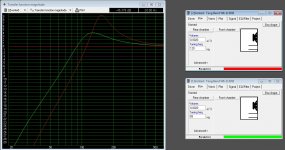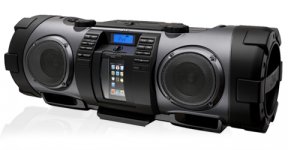I bought some of the aura ns6-255 6 inch woofers from parts express because they seem like decent speakers for 9 bucks and I was looking for high sensitivity speakers to go in my first boom box. I also bought these for the high end. the first boom box I built was just some car speakers in a cooler... I'm ready to take the next step and design a boombox from scratch.
I couldn't really find any super helpful guides via google search on how to use winsid. so i figured i would ask you guys since you've been so helpful already 🙂
how do I use winisd to help me design the right size enclosure? I plugged the specs of the driver into the program and it plotted one of those curve graphs I keep seeing around here.... but I don't really know what I'm looking at. what does a good curve look like? how about a bad one? what am I supposed to be tweaking, and where out of all of this does it tell me what size enclosure I should build?
thanks in advance for your help 🙂
I couldn't really find any super helpful guides via google search on how to use winsid. so i figured i would ask you guys since you've been so helpful already 🙂
how do I use winisd to help me design the right size enclosure? I plugged the specs of the driver into the program and it plotted one of those curve graphs I keep seeing around here.... but I don't really know what I'm looking at. what does a good curve look like? how about a bad one? what am I supposed to be tweaking, and where out of all of this does it tell me what size enclosure I should build?
thanks in advance for your help 🙂
I just did a GOOGLE search for "winisd tutorial"
Try this it might help:
Using WinISD: A Step by step tutorial
At the bottom of the first page is "Part Two - Designing Your First Enclosure! "
Have fun
Try this it might help:
Using WinISD: A Step by step tutorial
At the bottom of the first page is "Part Two - Designing Your First Enclosure! "
Have fun
thank you! that was the most helpful page I found before I made this post. it stops at page two though and doesn't actually get to the part where you turn the measurements from winisd into a box.
and I still don't know what good or optimal results look like in the program.
I'll keep digging though
thanks again!
and I still don't know what good or optimal results look like in the program.
I'll keep digging though

thanks again!
When you first plug the numbers in, you can choose either sealed or ported.
Normally, with a Qts of 0.55, you'd go sealed (this would give a flatter bass response). However, a boombox will always need all the help it can get in the bass - compared to a home situation, getting bass in half-space (sat on the floor, no walls around) is much more difficult.
Anyway.
Go ported.
Next up, forget about trying to go low in the bass. ~75Hz is sufficient. Tune the port somewhere around there, add an electrical low cut (AKA high pass) to stop low bass using up excursion. If the design has a bump in the bass before rolloff, all the better - the bump will make it sound like it goes much lower than it does.
Depending on how it's going to be used, you might want to mount the drivers to give a wider spread of sound - picture a cube, with the drivers on two adjacent sides.
You could also put the drivers back-to-back, creating a (pretty much) 360 degree sound.
Normal HiFi rules don't really apply here, so feel free to go a little crazy.
Chris
PS - I'd consider trying some other tweeters. The large radiating surface will lead to poor dispersion (compared to a small dome), and the sensitivity is lower than that of the woofers, so you'll need to find a way of boosting their signal.
Normally, with a Qts of 0.55, you'd go sealed (this would give a flatter bass response). However, a boombox will always need all the help it can get in the bass - compared to a home situation, getting bass in half-space (sat on the floor, no walls around) is much more difficult.
Anyway.
Go ported.
Next up, forget about trying to go low in the bass. ~75Hz is sufficient. Tune the port somewhere around there, add an electrical low cut (AKA high pass) to stop low bass using up excursion. If the design has a bump in the bass before rolloff, all the better - the bump will make it sound like it goes much lower than it does.
Depending on how it's going to be used, you might want to mount the drivers to give a wider spread of sound - picture a cube, with the drivers on two adjacent sides.
You could also put the drivers back-to-back, creating a (pretty much) 360 degree sound.
Normal HiFi rules don't really apply here, so feel free to go a little crazy.
Chris
PS - I'd consider trying some other tweeters. The large radiating surface will lead to poor dispersion (compared to a small dome), and the sensitivity is lower than that of the woofers, so you'll need to find a way of boosting their signal.
Hey Chris, thanks for your reply! I'll look into some higher sensitivity dome tweeters. I got the ones I have because they were cheap, and I chose tweeters that were less sensitive because I wanted more of the bass to come out. when I take my cooler radio out I have to turn it up pretty loud to get any decent bass out of it. it has a very sharp sound, and the speakers that handle the mids and highs are actually 3db less sensitive than the sub. it seems like sharp crisp little noises carry better outside than the bass.
so the bump right before it drops to -3db is a good thing? is a bigger bump better?
so the bump right before it drops to -3db is a good thing? is a bigger bump better?
Theoretically, bass should carry better than mid/treble. I suspect your cooler system has a tonal imbalance. How did you find out the sensitivity of the sub? It sounds like it may be lower than you think - you could plug the numbers into WinISD to find the sensitivity at LF.
For outdoors use, yes, the bump would be very useful. In terms of bigger = better?, I'd try to keep the bump fairly broad, instead of going for a very tall but narrow peak.
I've attached a sim using the TB 6.5" sub driver. Each time, its a 2L cabinet. However, I'd say the green trace is more preferable than the red trace: the red trace will sound very one-note (because that's what it is), because the peak is so narrow. The green trace should sound better.
Ignore the response after rolloff - add a cap in series with the amplifier input so the low bass is filtered out.
When you've built the system, use WinISD (or similar) to find a starting point for port tuning, and then play around from there.
Chris
For outdoors use, yes, the bump would be very useful. In terms of bigger = better?, I'd try to keep the bump fairly broad, instead of going for a very tall but narrow peak.
I've attached a sim using the TB 6.5" sub driver. Each time, its a 2L cabinet. However, I'd say the green trace is more preferable than the red trace: the red trace will sound very one-note (because that's what it is), because the peak is so narrow. The green trace should sound better.
Ignore the response after rolloff - add a cap in series with the amplifier input so the low bass is filtered out.
When you've built the system, use WinISD (or similar) to find a starting point for port tuning, and then play around from there.
Chris
Attachments
On a side note. Blocking the lower frequencies of some "full range" speakers I have might keep them from flapping during low bass hits. Do you know of a formula or a calculator I can use to come up with a nice value for a capacitor to use as a low high pass? I've seen car speakers that have a capacitor soldered to them, I never thought of it before but now I assume those are extremely simple crossovers. How can I find a value that will let everything over 70 hz pass?
On second thought, that's not a side note at all. It's sort of what you were talking about. I just want to test it out on my expendable speakers.
An Alternative
JVC Kaboom [1] is one of the best commercial boom-box performers available. It may serve as model for your design. Using PVC pipe you should be able to approximate it acoustically. I own an older model, which I use at the beach. Surprisingly, it can fill a large public space with fairly clean sound despite its small size. For success, use high performance drivers.
[1] Kaboom! System for iPod/iPhone - RV-NB70B
JVC Kaboom [1] is one of the best commercial boom-box performers available. It may serve as model for your design. Using PVC pipe you should be able to approximate it acoustically. I own an older model, which I use at the beach. Surprisingly, it can fill a large public space with fairly clean sound despite its small size. For success, use high performance drivers.
[1] Kaboom! System for iPod/iPhone - RV-NB70B
Attachments
- Status
- Not open for further replies.
- Home
- Loudspeakers
- Multi-Way
- trying to figure out what size enclosure to build for boombox

